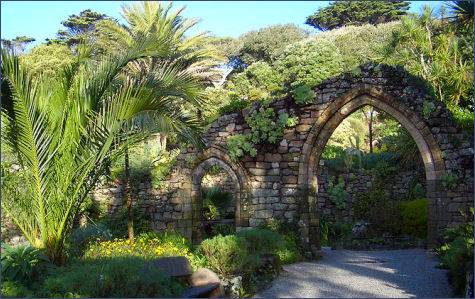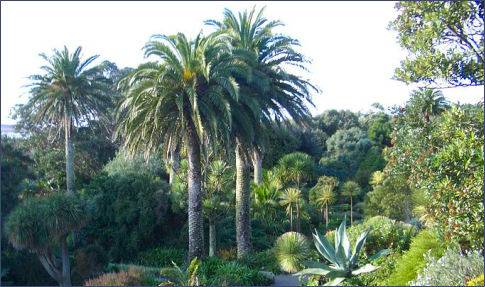Tresco Abbey Gardens
OS grid reference :-SV 893143
 The famous sub-tropical Tresco Abbey Garden on the Island of Tresco has been described as a perennial Kew without the glass, it shrugs off salt spray and Atlantic gales to host myriad exotic plants, many of which would stand no chance of survival even on the Cornish mainland less than 30 miles away.
The famous sub-tropical Tresco Abbey Garden on the Island of Tresco has been described as a perennial Kew without the glass, it shrugs off salt spray and Atlantic gales to host myriad exotic plants, many of which would stand no chance of survival even on the Cornish mainland less than 30 miles away.
Even at the winter solstice, there are more than 300 plants in flower in the garden. All in all, the tropical garden is home to more than 20,000 species of plants from 80 countries, ranging from Brazil to New Zealand and Burma to South Africa.
Tresco Abbey Garden was established by the nineteenth century by Augustus Smith, who had taken over the lease of the Isles of Scilly from the Duchy of Cornwall. It was originally a private garden within the grounds of his home.
Within the gardens stand the remains of a Benedictine Abbey founded in 964 AD, although the majority of what remains today comes from the Priory of St Nicholas founded by monks from Tavistock Abbey in 1114.
 There were hardly any trees on Tresco and the gorse did not provide enough protection so Smith resorted to planting "shelterbelts". The first consisted of mainly deciduous trees such as, elm, sycamore, oak, and poplar, but he later planted Monterey cypress and Monterey pine which are fast growing and suited to coastal conditions.
By building tall wind-breaks, Augustus Smith channelled the weather up and over the network of walled enclosures.
There were hardly any trees on Tresco and the gorse did not provide enough protection so Smith resorted to planting "shelterbelts". The first consisted of mainly deciduous trees such as, elm, sycamore, oak, and poplar, but he later planted Monterey cypress and Monterey pine which are fast growing and suited to coastal conditions.
By building tall wind-breaks, Augustus Smith channelled the weather up and over the network of walled enclosures.
Three terraces were carved out from the rocky, south facing slope looking towards the island of St Mary's. The hotter, drier terraces at the top of the garden suit South African and Australian plants; those lower down provide the humidity that favours flora from New Zealand and South America. The diversity of plant life to be found within the Abbey Garden is as extraordinary as it is unique.
Fringing the lush grid of paths which criss-cross the gardens are a host of succulents, towering palm trees and giant, lipstick-red flame trees. Here you can find flowers of the King Protea and the handsome Lobster Claw. Walk amongst the great blue spires of Echium, brilliant Furcraea, Strelitzia and shocking-pink drifts of Pelargonium.
The garden also contains a collection of shipwrecked figureheads, which are displayed at the Valhalla Museum.
There is a well-stocked gift shop and a large cafeteria at the entrance to the garden.